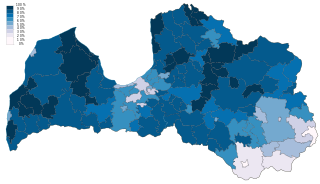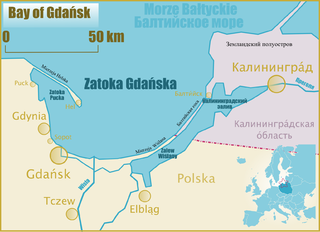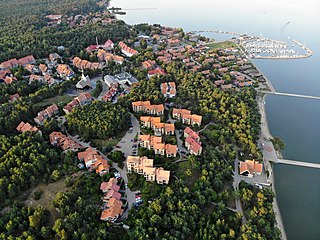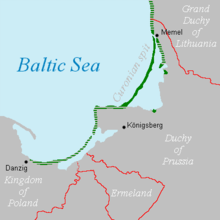
Demographic features of the population of Lithuania include population density, ethnicity, level of education, health, economic status, and religious affiliations.

Sambia or Samland or Kaliningrad Peninsula is a peninsula in the Kaliningrad Oblast of Russia, on the southeastern shore of the Baltic Sea. The peninsula is bounded by the Curonian Lagoon to the north-east, the Vistula Lagoon in the southwest, the Pregolya River in the south, and the Deyma River in the east. As Sambia is surrounded on all sides by water, it is technically an island. Historically it formed an important part of the historic region of Prussia.

Latvian, is an East Baltic language belonging to the Indo-European language family. It belongs to the Baltic subbranch of the Balto-Slavic branch of the family and it is spoken in the Baltic region. It is the language of Latvians and the official language of Latvia as well as one of the official languages of the European Union. There are about 1.2 million native Latvian speakers in Latvia and 100,000 abroad. Altogether, 2 million, or 80% of the population of Latvia, spoke Latvian in the 2000s, before the total number of inhabitants of Latvia slipped to 1.8 million in 2022. Of those, around 1.16 million or 62% of Latvia's population used it as their primary language at home, though excluding the Latgale and Riga regions it is spoken as a native language in villages and towns by over 90% of the population.

Klaipėda is a city in Lithuania on the Baltic Sea coast. It is the third largest city in Lithuania, the fifth largest city in the Baltic States and the capital of Klaipėda County, as well as the only major seaport in the country.

Gdańsk Bay or the Gulf of Gdańsk is a southeastern bay of the Baltic Sea. It is named after the adjacent port city of Gdańsk in Poland.

The Curonian (Courish) Spit is a 98-kilometre (61 mi) long, thin, curved sand-dune spit that separates the Curonian Lagoon from the Baltic Sea. It is a UNESCO World Heritage Site shared by Lithuania and Russia. Its southern portion lies within Kaliningrad Oblast of Russia, and its northern within southwestern Klaipėda County of Lithuania.

Klaipėda County is one of ten counties in Lithuania, bordering Tauragė County to the southeast, Telšiai County to the northeast, Kurzeme in Latvia to the north, and Kaliningrad Oblast in Russia to the south. To the west is the Baltic Sea. It lies in the west of the country and is the only county to have a coastline and not be landlocked. Its capital is Klaipėda. On 1 July 2010, the county administration was abolished, and since that date, Klaipėda County remains as the territorial and statistical unit.

Nida is a resort town in Lithuania, the administrative centre of Neringa municipality. Located on the Curonian Spit between the Curonian Lagoon and the Baltic Sea, it is the westernmost point of Lithuania and the Baltic states, close to the border with the Russian Kaliningrad Oblast exclave. It currently has about 2,385 residents.

Samogitians are the inhabitants of Samogitia, an ethnographic region of Lithuania. Many speak the Samogitian language, which in Lithuania is mostly considered a dialect of the Lithuanian language together with the Aukštaitian dialect. The Samogitian language differs the most from the standard Lithuanian language.

Lithuania Minor, or Prussian Lithuania, is a historical ethnographic region of Prussia, where Prussian Lithuanians lived, now located in Lithuania and the Kaliningrad Oblast of Russia. Lithuania Minor encompassed the northeastern part of the region and got its name from the territory's substantial Lithuanian-speaking population. Prior to the invasion of the Teutonic Knights in the 13th century, the main part of the territory later known as Lithuania Minor was inhabited by the tribes of Skalvians and Nadruvians. The land depopulated during the incessant war between Lithuania and the Teutonic Order. The war ended with the Treaty of Melno and the land was repopulated by Lithuanian newcomers, returning refugees, and the remaining indigenous Baltic peoples; the term Lithuania Minor appeared for the first time between 1517 and 1526.
Samogitian is an Eastern Baltic language spoken mostly in Samogitia. Although originally regarded as a Lithuanian dialect, Samogitian has since been recognized as a separate language inside and outside of Lithuania, obtaining increasingly more recognition as a distinct language in the recent years. Several attempts have been made to standardize it.
The Kursenieki are a nearly extinct Baltic ethnic group living along the Curonian Spit. "Kuršiai" refers only to inhabitants of Lithuania and former East Prussia that speak a southwestern dialect of Latvian. Some autochthonous inhabitants of Šventoji in Lithuania call themselves "kuršiai" as well.

The Battle of Durbe was a medieval battle fought near Durbe, 23 km (14 mi) east of Liepāja, in present-day Latvia during the Livonian Crusade. On 13 July 1260, the Samogitians soundly defeated the joint forces of the Teutonic Knights from Prussia and the Livonian Order from Livonia. Some 150 knights were killed, including Livonian master Burkhard von Hornhausen and Prussian land marshal Heinrich Botel. It was by far the largest defeat of the knights in the 13th century: in the second-largest, the Battle of Aizkraukle, 71 knights were killed. The battle inspired the Great Prussian Uprising and the rebellions of the Semigallians, the Couronians, and the Oeselians. The battle undid two decades of Livonian conquests and it took some thirty years for the Livonian Order to restore its control.

Nemunas Delta is the Lithuanian name for the Neman (Nemunas) River Delta, in Lithuania. Prior to post-World War II border changes, it was known in German as the Memel Niederung, as the Neman was for centuries called the Memel in German.

Klaipėda Castle, also known as Memelburg or Memel Castle, is an archeological site and museum housed in a castle built by the Teutonic Knights in Klaipėda, Lithuania, near the Baltic Sea. The Teutons called the castle Memelburg or Memel, and Klaipėda was generally known as Memel until 1923, when Lithuanian military forces took over the city. The castle was first mentioned in written sources in 1252, and underwent numerous destructions and reconstructions in the centuries that followed. During the 19th century, having lost its strategic importance, the castle was demolished. Archeological work was performed at the site during the 20th century, and in 2002 a museum was established underneath one of its bastions. Currently, the castle is being restored. The construction work is not scheduled to finish until 2020.

Żuławy Wiślane, in English known as the Vistula Fens, is the alluvial delta area of the river Vistula, in the northern part of Poland. It is a flat and deforested region comprising wetlands and agricultural plains that cover approximately 1,700 squared kilometres, with much of the land being situated below sea level. Poland's lowest point is located at Raczki Elbląskie in the Żuławy region.

The Curonian Lagoon is a freshwater lagoon separated from the Baltic Sea by the Curonian Spit. Its surface area is 1,619 square kilometers (625 sq mi). The Neman River supplies about 90% of its inflows; its watershed consists of about 100,450 square kilometres in Lithuania and Russia's Kaliningrad Oblast.

Kursenieki language or Curonian language of the Curonian isthmus is a dialect of the Latvian language spoken by the Kursenieki of the Curonian Spit, a thin strip of land stretching between southwestern Lithuania and the Kaliningrad exclave of Russia. In the process of various migrations of the 14th–17th centuries, Curonians settled along the Curonian Spit in East Prussia and became known as Kursenieki.

The Curonians or Kurs were a medieval Baltic tribe living on the shores of the Baltic Sea in the 5th–16th centuries, in what are now western parts of Latvia and Lithuania. They eventually merged with other Baltic tribes contributing to the ethnogenesis of present-day Latvians and Lithuanians. Curonians gave their name to the region of Courland (Kurzeme), and they spoke the Curonian language.
















